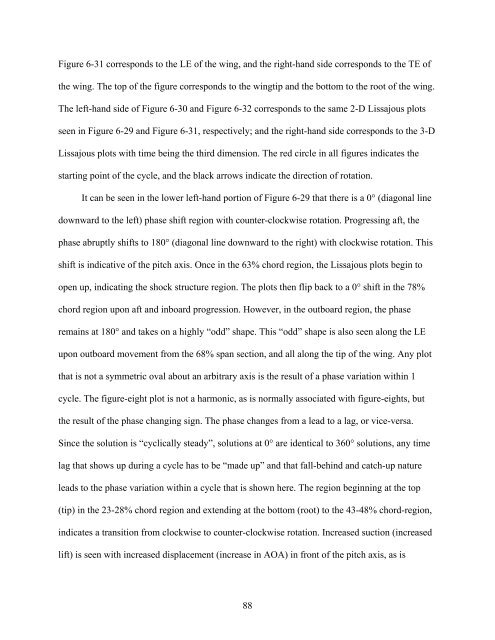university of florida thesis or dissertation formatting template
university of florida thesis or dissertation formatting template
university of florida thesis or dissertation formatting template
You also want an ePaper? Increase the reach of your titles
YUMPU automatically turns print PDFs into web optimized ePapers that Google loves.
Figure 6-31 c<strong>or</strong>responds to the LE <strong>of</strong> the wing, and the right-hand side c<strong>or</strong>responds to the TE <strong>of</strong><br />
the wing. The top <strong>of</strong> the figure c<strong>or</strong>responds to the wingtip and the bottom to the root <strong>of</strong> the wing.<br />
The left-hand side <strong>of</strong> Figure 6-30 and Figure 6-32 c<strong>or</strong>responds to the same 2-D Lissajous plots<br />
seen in Figure 6-29 and Figure 6-31, respectively; and the right-hand side c<strong>or</strong>responds to the 3-D<br />
Lissajous plots with time being the third dimension. The red circle in all figures indicates the<br />
starting point <strong>of</strong> the cycle, and the black arrows indicate the direction <strong>of</strong> rotation.<br />
It can be seen in the lower left-hand p<strong>or</strong>tion <strong>of</strong> Figure 6-29 that there is a 0° (diagonal line<br />
downward to the left) phase shift region with counter-clockwise rotation. Progressing aft, the<br />
phase abruptly shifts to 180° (diagonal line downward to the right) with clockwise rotation. This<br />
shift is indicative <strong>of</strong> the pitch axis. Once in the 63% ch<strong>or</strong>d region, the Lissajous plots begin to<br />
open up, indicating the shock structure region. The plots then flip back to a 0° shift in the 78%<br />
ch<strong>or</strong>d region upon aft and inboard progression. However, in the outboard region, the phase<br />
remains at 180° and takes on a highly “odd” shape. This “odd” shape is also seen along the LE<br />
upon outboard movement from the 68% span section, and all along the tip <strong>of</strong> the wing. Any plot<br />
that is not a symmetric oval about an arbitrary axis is the result <strong>of</strong> a phase variation within 1<br />
cycle. The figure-eight plot is not a harmonic, as is n<strong>or</strong>mally associated with figure-eights, but<br />
the result <strong>of</strong> the phase changing sign. The phase changes from a lead to a lag, <strong>or</strong> vice-versa.<br />
Since the solution is “cyclically steady”, solutions at 0° are identical to 360° solutions, any time<br />
lag that shows up during a cycle has to be “made up” and that fall-behind and catch-up nature<br />
leads to the phase variation within a cycle that is shown here. The region beginning at the top<br />
(tip) in the 23-28% ch<strong>or</strong>d region and extending at the bottom (root) to the 43-48% ch<strong>or</strong>d-region,<br />
indicates a transition from clockwise to counter-clockwise rotation. Increased suction (increased<br />
lift) is seen with increased displacement (increase in AOA) in front <strong>of</strong> the pitch axis, as is<br />
88
















